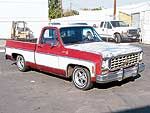
Last month, we gave you the "advanced-level" part of our '75 Chevy lowering/suspension rebuild. From hub to hub, Performance Online not only completely went through the pickup's front suspension--replacing pretty much every imaginable part with Spicer/Raybestos components--but also added a 4-inch Belltech drop kit (spindles and coils). Being that the Cheyenne was at stock height before all of this even started, you'd be correct to assume that we had to address the rearend sooner or later...well, now is later!
Unlike the frontend's complexities, lowering the rearend was quite the opposite. Save for a little cutting on the frame for the Belltech "bolt-in" notch plates, bringing the back down was a snap. Basically what you're doing is taking the stock leaf pack (you can buy new lowered leaf springs, but in a moment you'll see why it's not always recommended) and relocating it "below" the rearend itself. The Belltech spring plates not only replace the stock perches, but they act as lowering blocks, as well. Also, the new Nitro shocks bolt right where the stock ones went. How simple is that? Real simple. Now, being that we chose the 6-inch drop for the rear, having the additional lowered aspects of a dropped spring would have produced what some like to refer as a "speed-boat" stance (the rear being a bit lower than the front). If you chose less of a drop, say a 2-inch or even a 4-inch, then by all means, incorporating new leaf springs to make up the difference is not a bad idea (we were fine with the stock ones). If you prefer more of a "California rake," you'll probably not want to go as low out back... We've got some future frontend modifications in mind, so the 4-6 was fine for us!
Regardless of what particular drop you go with, make sure you keep your pinion angle within reason. If lowering affects the angle too much, be sure and pick-up some wedge shims (they are available in half-degree increments from most 4WD suppliers and old-timey alignment shops) to get your pinion back in line. Also, make sure your U-joints are all in good shape while you've got the driveshaft out (we found out the hard way that ours were bad--on the freeway driving home from the shop!). Other than that, enjoy your truck's new ride and stance!